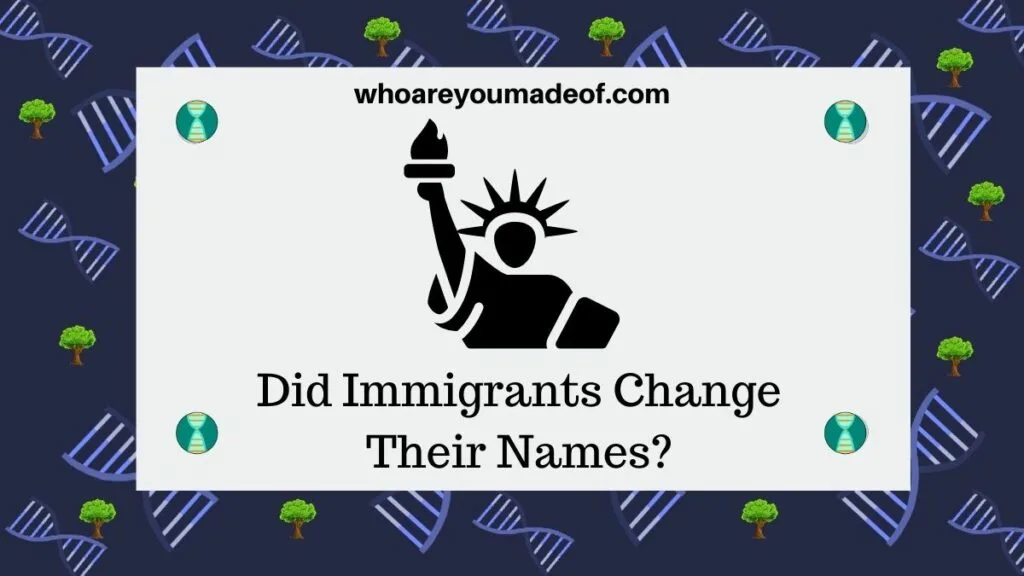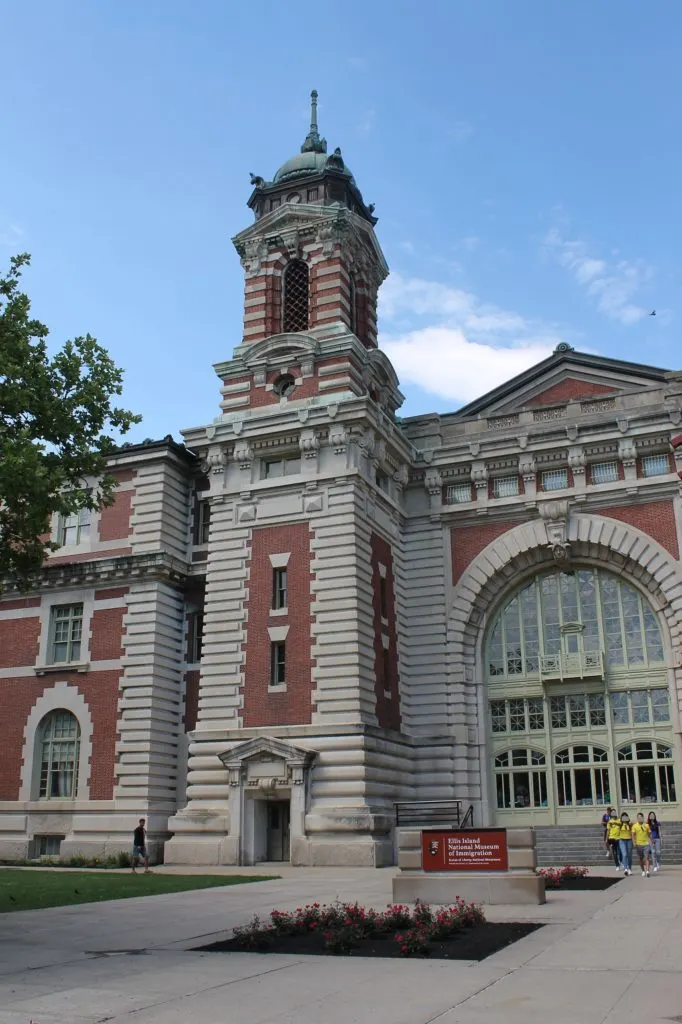Did your immigrant ancestors change their names when they came to America? Who did the name changes? In this post, learn the history of immigrant name changes in the USA in the late 19th and 20th centuries.
There is quite a bit of confusion about why, when, and how our ancestors who immigrated to the United States acquired names that were different than the ones that they were born with.

Anyone who has an ancestor who was born in a different country, which is almost every American, might find that their ancestors originally spelled their names differently, or had an entirely different name, in their home country.
Many of our families have passed down stories to explain the name change, but not every story is accurate. For example, my maternal grandmother who was of Polish and German ancestry, believed that her father's last name was changed at Ellis Island.
Why did my family believe our Polish ancestor's name change had taken place? Our family thought that an immigration official at Ellis Island had changed our ancestor's surname to something shorter and easier to pronounce.
Did Ellis Island change the name of immigrants?
No, Ellis Island immigration inspectors did not change the name of immigrants. In fact, they were not even responsible for documenting the names of the migrants who were processed there.
The Ellis Island name change story that my family told, or one like it, is very common in many families, but is there any truth to it at all? And if it isn't true, and we have evidence that our ancestors had different names in their country of origin, how did their name get changed?
In my family's case, careful genealogy research done by a cousin led to two important discoveries. First, my Polish great-great grandfather did not pass through Ellis Island, leaving Ellis Island immigration officials free of blame for any name change that may have occurred.
As it turns out, Ellis Island operated between January 1, 1892 and November 12, 1954. This means that my ancestor, who arrived in New York in 1885, could not have had his name changed by an Ellis Island official.

Image copyright 2018 Mercedes Brons
The second discovery my cousin made was that there was no name change during my ancestor's immigration to the United States. On the passenger manifest, his name was spelled incorrectly, yet my ancestor never used the incorrectly spelled name during his life in the United States.
Many people believe the myth about name changes on Ellis Island because it is easy to imagine, especially through our modern perspectives, a crew of English-speaking, monolingual immigration officials stumbling through lists of foreign names and coercing people into making their surnames easier to spell or pronounce.
In reality, this is probably not what the experience of most immigrants was like. On Ellis Island, the average inspector spoke an average of three languages, meaning that if your ancestor did pass through this inspection station, they very likely may have encountered an official who spoke their native language fluently.
Eventually, my Polish ancestor's surname did change. However, it was likely of his own accord, which I will discuss further down the page.
Where was the name and spelling of immigrants documented?
The names of immigrants were recorded at the point of sale where their ticket was purchased. The person who wrote down their name was an employee of the shipping line - a clerk or cashier - who worked at the station where the immigrant paid for their passage overseas.
The person who sold my Polish ancestor his ticket to cross the Atlantic was located in either Scotland or Ireland. My great-great grandfather didn't speak English, and it is unlikely that the clerk spoke Polish.
I'm sure that the clerk did the best that he could when he wrote my ancestor's name down, but he spelled it wrong. He probably spelled it like it sounded to him, which is what any of us would do if we were faced with a similar situation and a language barrier.
This means that most of the time, an incorrectly spelled name was just that - a spelling error, usually innocent in nature. Some of our ancestors fixed the spelling issue and others simply kept the "new" spelling of their name, which was sometimes a simplified version of their old one.
It's easy to see how this could lead us to jump to conclusions about motives.
When did immigrants change their names?
My family doesn't know the exact history of our Polish ancestor's name changes. Our situation isn't unique, either - especially for descendants of immigrants who arrived to the United States in the late 1800s.
Historically, it was very common for immigrants to change their own names, and they usually did so within the first few years of establishing their residence in America.
The Naturalization Act of 1906 passed by Congress made new requirements of immigrants wishing to become citizens of the United States. This law was passed for many reasons, one of which was because immigrants were known to change their names after arrival to the USA, and there was a need for better documentation.
After 1906, documentation for newly arrived immigrants was standardized and it became more difficult for a new immigrant to simply begin using a new name, especially for legal purposes.
As for my ancestor, we were able to document two small changes in the spelling of his name. His Polish surname originally contained the Polish letter "ą", which makes a sort of "n' sound in Polish.
Of course, we don't have a "ą" in the English alphabet.
My ancestor first used the originally spelling of his Polish name and substituted the English "a" for the Polish "ą", likely because they looked similar. However, the sound was completely different when pronounced in English.
Eventually, my ancestor dropped the English "a" and replaced the "ą" with a n", which, when pronounced in English, had a sound more similar to the original way his name was pronounced in Polish.
When my super-sleuth genealogist cousin realized this, it was an important breakthrough in the search for our ancestor's Polish origins. We had little chance of finding his Polish birth records without knowing what his name really was, after all.
When studying our ancestors, we must be diligent and creative. It's important to consider that the spelling of your ancestor's name, or even their entire name, may have changed at some point.
Why did immigrants to America change their names?
Our immigrant ancestors may have changed their names for any number of reasons depending on their unique circumstances. While some of them may have had mysterious origins they wanted to leave behind, most of them just wanted to fit in in their new home - the United States of America.
They may have changed their name from its original form to a spelling that is easier to pronounce, or to a completely new name that sounded more "American" during their lives. It may have been a way to attempt to assimilate, or to avoid discrimination.
Many times, it wasn't even the immigrants themselves that changed their names. Children of immigrants commonly changed their names for the same reasons that I stated above.
For example, the step-son of my Polish great-great grandfather, my great-great uncle, changed his last name to "Jackson". A very "American" name, simple to spell, which may have helped him move through his life without being marked as an outsider.
Do immigrants still change their names?
While some immigrants do change their names after moving to the United States, the practice has become less popular. This is because our country is becoming more diverse and accepting, leaving people more comfortable keeping their original names that don't sound "American" in origin.
When an immigrant applies for citizenship nowadays, they are given the option to legally change their name. According to immigration officials, less than 20% of immigrants opt to legally change their name during their naturalization process.
My family has first-hand knowledge of this experience, as my husband decided to legally change his name when he became a US citizen in 2017. He is from a Spanish-speaking country where people take the last name of their father and their mother, though the name that they use in most situations is the name of only the father.
When he started the immigration process, he used both last names. During the citizenship process, he decided to drop his "second" last name in order to avoid having a super-long surname consisting of two words.
Plus, the whole two name concept is confusing for a lot of Americans. It is much easier for my husband to navigate US society with only one last name.
There are indeed a million reasons that an immigrant might decide to change their name.
Conclusion
I hope that you have found this article interesting, and that you have learned more about when, how, and why your immigrant ancestor may have ended up with a name different than the one with which they were born.
If you have any questions or comments, I would love to hear from you in the discussion below.
Thanks for stopping by and reading today!

Bernadette
Sunday 21st of February 2021
Interesting explanation. It would make sense that the shipping clerk’s spelling or misspelling would end up on the ship’s passenger list. My great-grandfather’s last name evolved from Cserniga or Cerniga on ship and church records to “Shenigo.” My grandfather’s original name was Vasyl Terniak. He changed his first name to Charles, apparently to be more “American,” although he never applied for citizenship. Terniak evolved into “Turnick.” Both were from what was then the Austro-Hungarian Empire. My great-grandfather’s birthplace is now in eastern Slovakia. My grandfather’s is in western Ukraine.